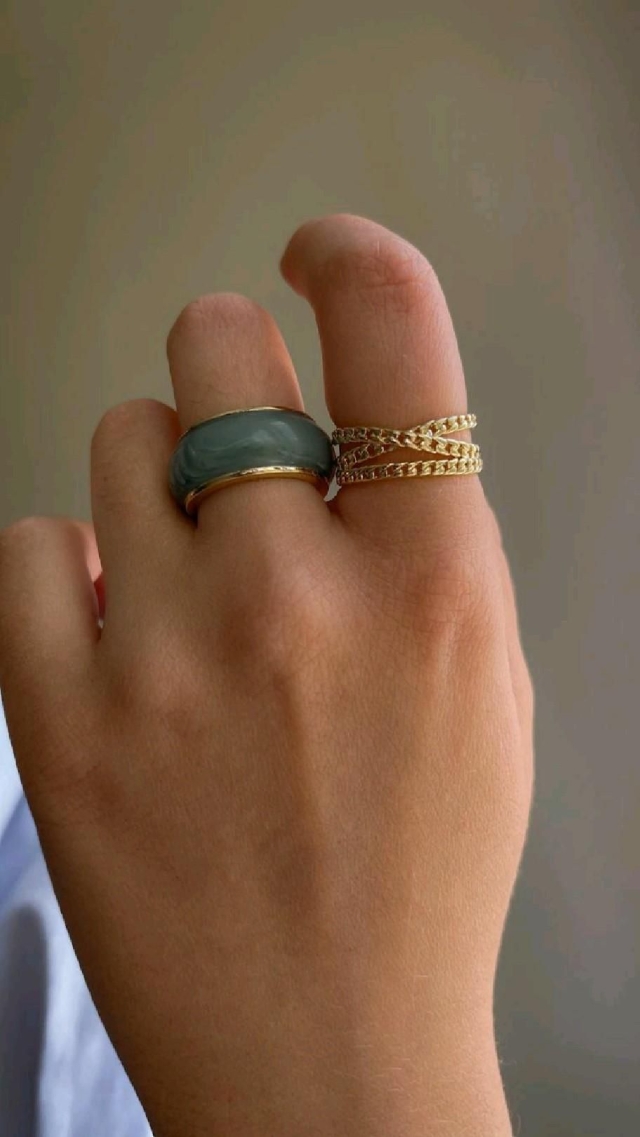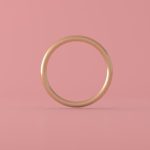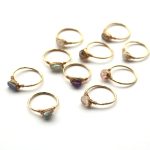One of the most exciting aspects of collecting vintage jewelry is that it takes you on a time portal into the past. However, as with any craft or skill there are ways to maintain and repair and restore your costume jewelry pieces back to their original shape and form. Understanding how to repair vintage costume jewelry can be quite difficult but there are some simple steps that can help the diligent collector enjoy their collectibles for years to come.
The First Step: Cleaning
Cleaning your vintage jewelry is a high priority when trying to preserve its original quality. Visually inspect your pieces for any dirt buildup or grime that may prevent its natural shine or distort design elements of the piece. Start by cleaning on low settings with either a soft tooth brush or cloth covered in mild soapy water (avoid harsh chemicals).
If the grime is particularly stubborn, try using toothpaste since it contains just enough abrasive materials to do a good job without damaging the piece. Hit extra tarnished areas with a cotton swab coated in minimalist silver polish or steel wool if necessary Make sure that you rinse off all residue very carefully before proceeding with drying and buffing.
The Second Step: Buffing
Once you have thoroughly cleaned your vintage costume jewelry, this next step is essential for restoring its shine. Using a clean dry cloth like microfiber does work best however almost any fabric will do as long as it’s clean and dry. Simply use circular motions to buff out every corner and smooth away scratches along nicer finishes gently so as not to create too much friction which can damage the metal over a period of time.
Metal polish can also help here providing you go slowly until you achieve the desired effect but I would only really recommend this for deep set discolorations in deeper metals such as palladium or any other dark events finish found on some vintage stuff.
Finally after you’ve finished buffing apply paste wax made specifically for metals to create an additional layer of protection against further corrosion or dampness caused by environmental conditions – something which especially important during cold humid winters or rain seasons.
Conclusion
With these two simple steps – cleaning followed by buffing – repairing vintage costume jewelry can be an easy process for even those not yet well versed in repair techniques involved with antique pieces of artistry from days gone by. Don’t be afraid to give it try once everything is said and done properly treating them will provide enjoyment from your treasured itemsand increase their longevity now and into the future.
Identifying Genuine Vintage Jewelry
When it comes to repairing vintage costume jewelry, identifying genuine pieces is essential. This can be a bit trickier than with vintage fine jewelry because of all the fakes and reproductions out there that may look like the real deal. However, with a keen eye and some detective work, you’ll be on your way to becoming an expert in recognizing authentic vintage costume jewelry.
For starters, it is important to remember that reproductions tend to have high-quality plating, whereas vintage items do not. Genuine pieces will often show some wear over time. The best practice is to examine the piece from several angles and even use a magnifying glass if necessary.
Look for small details such as the construction – older jewelry tends to be made from heavier materials that contemporary versions will not replicate. Pay attention to the pattern of how each component was crafted together too – old pieces were produced by hand and each one is unique in their own regard.
In addition, environment plays an important role in determining quality and authenticity of jewelry pieces. Vintage wares are typically made using metals like brass or silver coated in nickel or gilt which can form a patina when exposed to air and sunlight over time.
While these changes occur naturally over ancestors of years, modern imitations usually lack this characteristic because they are dipped into coloured pigments rather than being covered with organic material like lacquer which allows them to age more gracefully and authentically.
Assessing the Damage of Your Vintage Jewelry
When dealing with vintage jewelry repair, you should always begin by assessing the damage of your piece. Specifically, look at any broken frames or open loops that need mending and determine which type of plating the jewelry is made with.
If the costume jewelry features colorful enamel, you’ll also want to inspect it closely to identify any chipped or cracked areas. Depending on the severity of the damage, you may be able to make a quick repair using household products like superglue and small paintbrushes if restoring enamel is necessary.
Working With Soldering Irons For Fine Jewelry Repair
For complex repairs that require joining two separate pieces of metal together, soldering irons can provide reliable results for vintage costume jewelry restoration projects. When working with a soldering iron, it’s important to prepare both elements before placing them together with flux and solder to ensure a durable connection in the finished product.
Even if you don’t have experience working with flux and solder before, soldering irons can typically be found at most craft stores that come with an assortment of tips designed specifically for different repairing applications.
Reducing Visible Damage Through Polishing
Once you’ve assessed the damage of your worn-down costume piece, you may realize that polishing might be necessary to restore its original shine and coloration. By utilizing buffing materials like cloths and polishing compounds as well as tools like electric drills, Dremel tools and electric files, much of the scratches that have built up on your vintage piece over time can be eliminated and replaced with sleek reflections instead.
Additionally, polishing techniques can easily be learned from online tutorials if desired in order to minimize visible damage from occurring further down the line when handling vintage costumes pieces in particular.
Gather Appropriate Tools for Repairs
When it comes to repairing vintage costume jewelry, the key is in gathering the right tools. Depending on what kind of damage has been done and what type of repair needs to be done, the type of tools you need may vary.
Some basics would include metal tweezers for handling small pieces, a magnifying glass for a closer look at intricate details, an X-Acto knife for making precise cuts or notches, various adhesives and epoxies for attaching broken pieces, soft rubber erasers for brightening tarnished areas and fine sandpaper for smoothing rougher edges. Having the appropriate tools handy will help you make sure that your repairs are properly completed with satisfaction anticipated with every finish.
Perform Another In-Depth Examination
Before starting on any repairs it’s important to give your item an extra once-over assessment before getting started on any repairs. Make sure all parts are accounted for and consider how they’re put together and don’t rely solely on visuals; sometimes old clasps stick together unknowingly but can cause damage when pulled apart forcefully.
If it is possible, use a magnifying glass to examine all tiny creases, both of them visible and invisible to make sure no cracks or chips are involved before attempting certain glueing techniques as this can permanently damage your vintage piece if not handled appropriately.
Choose Appropriate Adhesives
Depending on what type of repair needs to be done employing the correct adhesive goes without saying as using the wrong one can cause further harm than good. For example if working with enamel like paint finishes superglue is not adviseable as this can leave marks behind which alter or ruin any decoration upon contact.
On top of that depending on material and clearness of bond desired various products exist; epoxy glues designed specifically for costume jewellery report strong bonds but take longer to dry so patience is a must where this substance is involved.
Once decided each adhesive recommendation comes with its own specific instructions so mindful attention should be paid when applying them being sure to follow instructions provided by the product itself precisely in order adhere correctly avoiding future complications regarding fixture security.
How to Care for Your Vintage Jewelry Properly
Maintaining the appearance of vintage costume jewelry is important, but repairing it can be a real challenge. If you’re wanting to fix your damaged heirloom pieces, there are a few things you need to keep in mind. First, identify what the issue is. Is the clasp broken?
Has the beadwork come undone? Do certain pieces of brooch or earring settings need repair? Knowing what exactly needs to be fixed will help you assess how difficult a project this might be and how much time it might take.
Once you’ve identified where your repairs need to begin, inspect each piece closely and make sure that all components have been accounted for. This step is important if the piece needs to be completely redone, especially when working with metals such as silver or gold. Depending on the complexity of repairs needed, this could determine whether this is a job for an expert or something you think you can handle yourself.
When patching up pieces at home it’s also crucial to know what type of materials and tools will be used so that they won’t damage the original surfaces or set off any firesong alarm bells (for antique items). You should start by using tweezers, small screwdrivers and pliers for manipulation of wires and other flexible components.
Pinching small bits of wire that haven’t been wired together well can help re-connect them safely without introducing more strain than necessary while bending paperclips tightly around squared-off moulded stones often works wonders in restoring their settings too. Lastly, having a pair of needle-nose pliers is ideal for manipulating delicate strands whilst avoiding crushing stones or scratching metal – all three tools should always be gently used.
When making repairs on-the-go use carefully selected materials such as glue or epoxy (commercially available products work wonderfully) for fixing existing elements instead of buying new ones as it helps maintain its originality; this saves potential shoppers from second guessing what they’re buying if they find out later it has been heavily altered.
Ultimately however, nothing surpasses professional expertise when dealing with intricate problems encountered by complicated but beautiful vintage costume jewelry designs – so if in doubt call an expert.
Tighten Loose Stones and Fix Missing Stones
Repairing vintage costume jewelry is a delicate process. The materials used to make it are so fragile that the slightest mistake can result in permanent damage to the piece. That being said, with a little guidance and patience, repairing vintage costume jewelry can be easier than you think. One of the most common repairs is tightening loose stones or fixing missing stones. In this article we will discuss these two repairs.
The first step to take when looking to tighten loose stones is by examining the setting for any visible signs of wear or corrosion. If there are any signs of corrosion then the metal may need to be experienced with an appropriate jewelry cleaning solution before repair begins. Next examine all of the prongs or other settings holding the stone in place and ensure that none are bent out of shape.
Once verified, begin carefully using the tip of your pliers to gently press any loose edges up against the stone and work them back into their original positions if needed. Make sure not to over tighten as this could cause more wear and tear on the metal setting itself and possibly cause it to wear out faster in future use.
To address missing stones, it’s best to start off by finding a replacement that’s similar in color, size, shape and quality as possible – synthetic gems often appear darker than natural gems so it’s worth taking this into consideration when searching for a replacement stone.
This stone should then be cleaned before being set in place into where it will fit securely and flush within the surrounding material – either with an adhesive such as specialized epoxy or welded into place with a soldering iron for metal settings only like gold or silver based pieces.
To ensure a secure fit, consider reinforcing existing prongs or adding extra ones if needed after placing in your new stone – preferably without welding if possible (depending upon material). Lastly polish off any excess glue from around the repair area once dried much in same manner you went about cleaning parts before hand prior inspection stage earlier on.
Once these two processes have been completed successfully your vintage costume jewelry should look as good as new. It’s important to exercise care when performing repairs like these, however if approached slowly and methodically there shouldn’t’ be anything restraining you from restoring pieces close hearth treasures intended last over years own personal timekeeping.
Cleaning and Replacing Clasps
Repairing vintage costume jewelry can be a rewarding but challenging task. It is important to know what techniques and tools to use in order to not damage the delicate pieces. Regardless of your skill level, there are some steps that you can always take to make sure that your repairs are successful. The first of these is cleaning the jewelry piece and replacing any old, worn out clasps or pins.
The most important thing when it comes to cleaning vintage costume jewelry is using the appropriate cleaning solution. You must choose something that will not strip away the patina or fade any of the accents on the piece. Never soak a piece in a harsh cleaner such as bleach as this can cause serious damage.
Often, warm water with a small amount of dish washing soap can be enough for basic cleanup. If your piece has gemstones or other precious materials, you may want to choose a cleaner made specifically for those elements such as ammonia-free solutions or jewelry polishes made for delicate items. Additionally, use soft-bristled brushes such as toothbrushes for highlighting details on your design and for getting into tight spaces between intricate pieces and stones.
Once you have finished cleaning your vintage costume jewelry, if needed, replace any clasps or pins on it with new ones of equal size and shape. After determining the best clasp needed and purchasing it from an online source or local craft store, you will need specialty tools such as jump ring pliers or needle-nose pliers in order to attach them properly without damaging the surrounding metal and stones on the piece itself.
Applying firm pressure onto each side of the old ring until it splits apart should open up space for you to slide in the new clasp tightly closed onto it.
Be sure to use gentle motions during this process so that you do not damage anything else unintentionally. Finally, adding a dab of metal glue might help add extra strength and durability while allowing you more control over its placement around other components on your prized item if need be.
When repairing vintage costume jewelry remember proper safety measures and cleanliness while completing each step carefully should result in a successful repair project. Double-check all connections before wearing it again, so nothing gets pulled off by accident. With some patience and practice when working with these projects – anyone has what they need to become an avid collector, inspector, restorer and wearer of timeless classic antiques.
Tips on Specific Techniques for Restoring Vintage Jewelry
Repairing vintage costume jewelry can sometimes be a difficult task for those not familiar with the process. Unfortunately, due to their low cost and abundance of materials such as glass, metals, plastics and stones; vintage costume jewelry is often considered obsolete or unrepairable.
The good news is that vintage costume jewelry can almost always be brought back to life with a little bit of patience, time, knowledge and TLC. Here are some of the most important tips to keep in mind when repairing vintage costume jewelry:
Firstly, it’s important to assess the type of damage when repairing your item. If it’s simply a matter of missing or damaged stones, then you’ll have to consider replacing them before doing any other repairs.
Depending on the piece, you may have access to similar replacement materials at craft stores and antique shops. However, if you find that the metal components have corroded or stamped pieces have weakened, then it’s best to consult with a qualified jeweler who specializes in repairing vintage pieces for an opinion on your best options moving forward.
The next step is preparation. Prier to making any repairs first use mild soap and warm water (not hot.) along with a soft cloth.
Pay attention to crevices between pieces where dirt can accumulate over time; carefully cleaning these areas will help make sure all parts fit properly once reassembled. Additionally rubbing alcohol is great for cleaning any stubborn residues that are present on the item; however it should only be applied directly onto parts containing metal since it may also strip off color from plastic and acrylic beads used within some designs.
Once prepared you will need specific tools depending on what needs done – pliers (needle nose preferably) tweezers & magnifying glasses are generally standard and should work for most minor & simpler tasks such as removing existing jump rings or replacing small gemstones or crystals into settings. This being said larger jobs such as soldering and gluing may call for specialized equipment which may require going outside of your tool box or having skilled assistance*.
You can look-up tutorials online if needed – just remember safety first.
In conclusion repairing vintage costume jewelry may initially seem daunting but with patience and knowledge its possible yours too can be restored. Before starting however ensure that necessary supplies are gathered and instructions understood (you don’t want your one of kind piece undergoing unnecessary strain.).
By following these steps you limit the potential risks associated with working on older items which there output value often outweighs those taken to bring them back up-top again are well worth it – go forth & wow everyone wibth that newly found treasure.
*Due note: DIY repaires can cause further damage so please consider consulting a professional before engaging in more complex repairs.
Re-Plating and Refurbishing Older Jewelry Pieces
If you love collecting vintage costume jewelry, then you should be aware that with age comes wear and tear. When this occurs, repairing the items becomes necessary in order to preserve one’s beloved collections. One of the common ways to repair such pieces is known as re-plating. This method allows the wearer to restore a piece of jewelry with its original surface finish and often results in an item that looks virtually new again.
The process involves adding a thin outer surface layer of another precious metal on top of the existing piece, which effectively covers up any existing damage or signs of wear. Gold is often used because it provides superior resistance against discoloration as well as protection from scratches and chips. Some other metals used for re-plating include sterling silver, stainless steel, brass, and rose gold.
After determining what type of metal should be used for the job, an experienced technician will then carefully strip away any tarnish from the original material before adhering the new plating. It’s important to use a laboratory grade solution during this step of the process to ensure that no further damage is done to the piece in question.
After all is said and done, additional refinements can be made in order to ensure that every detail has been taken care of. The method employed depends largely upon whether or not stones are part of the antique item; if they are, they’ll likely require a few polishing techniques to bring out their natural shine once again.
Careful cleaning and polishing may also be required for other parts such as various loops and fasteners, so don’t forget about those when considering repairs on your vintage costume jewelry collection.
Proper attention paid at this stage can make an enormous difference in terms of overall result. Finally – once all repairs have been completed – keep in mind that given a little extra care and maintenance over time your favorite pieces become look like new again.
Final Thoughts & Recommendations
Repairing vintage costume jewelry can be a tricky affair but if done correctly, it can look just as good as new. The first step is to determine what type of materials the piece is made of and how extensive the repairs will be.
It is important to understand that complex repairs may require professional help and further care should be taken to ensure that no damage or additional wear occurs while attempting the repair. Knowing when work should be left in the hands of a professional greatly reduces any risk of damaging the item beyond repair.
When considering repairs for vintage costume jewelry, it is important to understand various factors such as age, condition, and material composition prior to beginning DIY fix-it attempts. Many vintage pieces contain delicate or rare materials making them prone to breakage when one is not careful. Also take into account whether or not particular items have significant value or can easily be replaced with something similar in quality.
With all things considered, repairing vintage costume jewelry requires some expert knowledge and patience. Before attempting any home repairs on a delicate piece, research online resources such as forums and video tutorials in order to gain an understanding of proper techniques and universal best practices.
Visiting a trusted jeweler or local museum craftsperson can also provide a wealth of valuable insight into the process. Working with these pre-existing experts allows one to avoid any potential pitfalls making sure your cherished jewelry lasts you another generation.

Welcome to my jewelry blog! My name is Sarah and I am the owner of this blog.
I love making jewelry and sharing my creations with others.
So whether you’re someone who loves wearing jewelry yourself or simply enjoys learning about it, be sure to check out my blog for insightful posts on everything related to this exciting topic!





